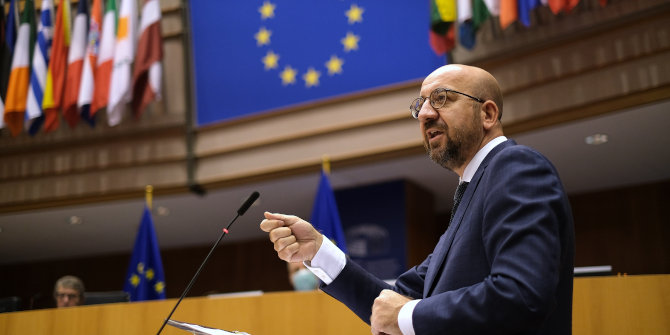In December, EU leaders agreed to set a new target of reducing greenhouse gas emissions to at least 55 per cent of 1990 levels by 2030. Drawing on new research, Michèle Knodt and Jonas Schoenefeld detail the role ‘harder soft governance’ might play in making this target achievable.
The EU’s decision in December to increase its climate target to at least a 55 per cent greenhouse gas emissions reduction by 2030 was the first big success of the European Green Deal (EGD) launched by Commission President Ursula von der Leyen. To reach the 55 per cent target and the EU’s ambitious net zero emissions target by 2050, the Commission presented three policy scenarios in an impact assessment accompanying the decision.
This included a regulatory-based scenario (REG) focused on regulative measures, and a carbon-pricing based scenario (CPRICE) which would extend the EU emissions trading system (EU ETS) to the transport and building sectors and to smaller industrial plants as the key instrument. The Commission however prefers a third option, a so called ‘MIX-scenario’, which combines regulatory measures with an extended EU ETS. It considers the latter easier to enforce.
Crucially, both the REG-scenario and the MIX-scenario can only deliver the 55 per cent reduction target if the existing enforcement mechanisms at the disposal of the Commission are tightened. In other words, achieving the new greenhouse gas reduction target is only possible in these two scenarios if the ‘soft governance’ of renewable energy and energy efficiency, which are central components in achieving the target, is ‘hardened’.
But what are the prospects of hardening this ‘soft governance’? While debates over soft governance (i.e. governance by non-binding measures such as political declarations, recommendations or policy monitoring) have long been of interest to scholars and practitioners, there has been a tendency in recent years to introduce new policy elements to ‘harden’ these soft arrangements. This development demands attention. In the case of climate and energy policy, the EU began to shift in this direction with its Governance Regulation for the Energy Union in 2018. In doing so, it sought to address the EU’s lack of competence over energy policy and the disadvantages of soft governance.
In a recent special issue, we have presented a series of analyses of this policy turn in light of cases where the EU and other institutions such as the United Nations Framework Convention on Climate Change (UNFCCC) or the OECD rely on ‘harder soft instruments’, meaning a combination of recommendations, monitoring and political declarations with obligations, public pressure and/or sanctions to nudge the member states in the desired direction. Our collective work reveals a new trend in EU public policy and provides theoretical and empirical starting points for a new discussion.
Harder soft governance and EU climate policy
The point of departure for ‘harder soft governance’ is that soft governance mechanisms have not always generated the desired effects. Too often, European-level policy coordination has not been translated into concrete action in the member states. In these cases, the European Commission and other institutions have become creative, using a range of additional tools to harden otherwise soft governance. This process has meant that, for example, soft governance in one policy field has been coupled with other fields where sanctions are possible, as in the case of the European Semester; or that additional publicity concerning the actions undertaken by member states has produced a ‘naming-and-shaming’ effect.
Harder soft governance can be traced across multiple fields and organisations and is therefore an increasingly widespread phenomenon. It is present in EU climate policy monitoring; in the EU’s Energy Union; in international climate governance; in the OECD; in the EU’s open method of coordination; in the European Semester and in policy surveillance in transnational city networks.

Credit: Gerry Machen (CC BY-ND 2.0)
The emergence of harder soft governance is especially clear in the Energy Union and in the corresponding Governance Regulation. In 2016, the Commission had proposed an ambitious governance strategy in order to transform the European energy system with a view to the Unions’ 2030 climate and energy targets. In 2018, the EU then adopted the Governance Regulation to harden its otherwise soft governance with elements such as the obligation for member states to take ‘due account’ of (non-binding) recommendations of the Commission and obligatory public debates in the areas of renewable energy and energy efficiency. But the first year of experience with the Governance Regulation revealed that it requires additional hard elements to tap its full potential.
In a similar vein, climate policy monitoring in the EU – a long-standing activity that dates back to the creation of international climate governance in the early 1992 – has recently been enhanced in various ways. The European institutions have sought to make the monitoring data on member state policy efforts to curb greenhouse gas emissions much more public by creating new online tools. They have also aligned the monitoring more closely with other policy processes, notably the effort sharing mechanism, where the member states decide who contributes how much. In summary, these enhancements serve to increase the consequentiality of the monitoring data and put pressure on the member states to act.
What drives the emergence of harder soft governance?
For harder soft governance to emerge, there typically must first be a soft governance mechanism that is perceived to be inadequate. The process does not arise naturally, but requires the activities of skilful policy entrepreneurs and corresponding institutional opportunities. It is thus a purposeful form of governance. In the case of the Energy Union, the European Commission has for example been particularly active in finding ways to increase the pressure on member states to follow its recommendations, particularly in cases of ambition or delivery gaps. It has pushed for a formula to informally calculate member state contributions to greenhouse gas reductions; and it has strengthened its leverage to react through delegated acts.
However, the efficacy of this new harder soft governance approach in generating tangible policy outcomes remains partly unknown. In part, this is because many harder soft governance mechanisms are rather new and will therefore need time to unfold and generate demonstrable effects. Studying such effects will however also require a much better conceptualisation of the causal mechanisms that run from harder soft governance to concrete outcomes. Scholars working on multilevel governance systems and on policy implementation have made important inroads into potential pathways to this effect. Going forward, the exploration of harder soft governance will require further theorisation and corresponding empirical testing.
We invite future scholars to take up these ideas and go the next step in studying modern-day European governance. Doing so will be key to better understanding the prospects of delivering on the principles of the European Green Deal and the new 2030 greenhouse gas reduction target. The political compromise among the member states that led to the 55 per cent target may hamper any hardening of the Governance regulation because it includes a concession towards Poland and Hungary that the right of the member states to decide on their national energy mix will be respected. The outcome of implementing either the REG- or MIX-scenario and thus the achievement of the new climate target hangs significantly on the efficacy of future harder soft governance approaches.
For more information, see the accompanying special issue at the Journal of Environment Policy & Planning
Note: This article gives the views of the authors, not the position of EUROPP – European Politics and Policy or the London School of Economics. Featured image credit: Gerry Machen (CC BY-ND 2.0)




